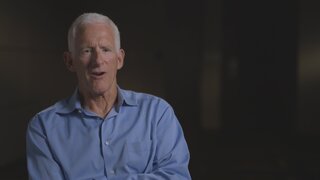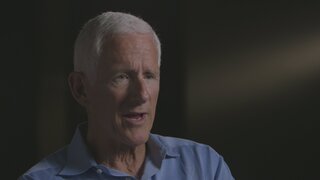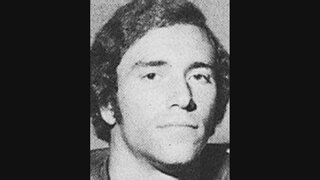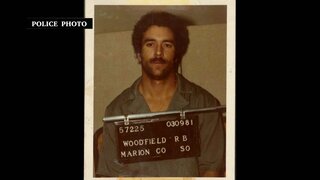How Did Former Green Bay Packer Randall Woodfield Turn Into The ‘I-5 Killer’?
Serial killer Randall Woodfield murdered at least seven people throughout his Interstate 5 crime spree, targeting victims from Northern California to Washington.
During his five-month reign of terror up and down the Interstate 5 corridor, serial killer Randall Woodfield’s M.O. changed often.
He committed robberies, rapes, and murders, attacking women he knew as well as total strangers. He stabbed, beat, and shot his victims and used a variety of disguises.
His only constants were brutality, violence, and mayhem, and his crime spree is explored in “Mark of a Killer,” airing Saturdays at 7/6c on Oxygen.
There was no reason to believe Woodfield would grow up to be a serial rapist and murderer. Born in 1950, “Randy,” as he liked to be called, came from a good home and grew up with his two older sisters in picturesque Otter Rock, Oregon on the Pacific Coast.
His father was a manager with the phone company, and his mother was a stay-at-home housewife, according to The Oregonian newspaper. Woodfield’s father pushed him into sports, and as teenager, Woodfield attended nearby Newport High School, where he played football, basketball, and ran track.
At one point, he got into trouble for being a “Peeping Tom” and was apprehended for exposing himself to females on a bridge in town, according to the Portland Tribune newspaper. His coaches allegedly knew about the incidents, but they kept them quiet, reported the outlet. His juvenile record was expunged when he was 18.
Following his high school graduation in 1969, Woodfield attended Treasure Valley Community College in Ontario, Oregon. While a student there, he was arrested for ransacking the apartment of a former girlfriend. He was found not guilty due to a lack of evidence, according to Sports Illustrated magazine.
Woodfield later transferred to Portland State University, where he played for the Portland State Vikings as a wide receiver. At PSU, he became active in a student group called Campus Crusade for Christ.
“He came off as a real religious-type person, but he was just different from the rest of his teammates,” PSU teammate Anthony Stoudamire told the Portland Tribune. “He was the one who didn't fit in. He'd say out-of-the-blue, off-the-wall statements.”
Woodfield’s troubling behavior continued at PSU, and during his tenure there, he was arrested multiple times for exposing himself and twice convicted, according to Sports Illustrated.
"One summer — it might have been his junior year — he got into some trouble in a parking lot outside of Memorial Coliseum,” PSU offensive coordinator Mike Brundage told the Portland Tribune. “He was exposing himself.”
Woodfield was remembered as a decent player, but many were surprised when he was drafted in 1974 by the Green Bay Packers. "He ran really good pass routes, but he had just fair hands and did not like contact," PSU teammate Scott Saxton told the Portland Tribune. “Maybe the coaches thought he was all that, but the rest of us were like, 'He got drafted? You kidding me?'"
Woodfield’s career in the NFL wouldn’t last the year. He was released by the Packers during the pre-season. Staying in Wisconsin, he was picked up by the semi-pro Manitowoc Chiefs, but he was let go at the end of the season.
Neither team gave a reason for cutting Woodfield, and although there are no records of him being arrested in Wisconsin, a detective later learned that Woodfield had been allegedly involved in at least 10 cases of indecent exposure across the state, according to Sports Illustrated.
After his dreams of being a professional football player ended, Woodfield returned to Portland, Oregon and began victimizing women. Woodfield robbed women at knifepoint and forced them to perform oral sex, according to New York’s Daily News.
He was apprehended after the Portland Police Bureau set up a sting operation in a local park with an undercover female officer. In custody, he told authorities he had impulse-control issues, “sexual problems,” and used steroids, according to Sports Illustrated.
After pleading guilty to reduced charges of second-degree robbery, Woodfield was sentenced to 10 years in the Oregon State Penitentiary. He earned parole after four years and was back on the streets by 1979.
Woodfield was released from prison just in time for his 10-year high school reunion. There, he reconnected with former classmate Cherie Ayers. On Oct. 11, 1980, she was found raped, stabbed, and bludgeoned to death in her Portland apartment, according to Sports Illustrated.
Ayers was Woodfield’s first known murder victim, and her death marked the beginning of a five-month crime spree up and down Interstate 5, from Northern California to Washington. Currently linked to seven deaths, some believe he may have committed up to 44 murders and 60 rapes, according to the Daily News.
Woodfield also committed numerous armed robberies, targeting small businesses along I-5, including convenience stores, ice cream shops, and gas stations. He often sexually assaulted any female staff on the premises and left many witnesses.
Those who survived his attacks described an assortment of different disguises Woodfield would use. He frequently wore a bandage or athletic tape over the bridge of his nose, thinking it would distract his victims and make him hard to identify, according to The Oregonian. Other times he wore a fake beard or a hooded sweatshirt, according to the Seattle Post-Intelligencer.
From his first murder on, Woodfield was considered a suspect due to his connections to several of the victims and his time behind bars. The initial evidence against him, however, wasn’t indictable, and he refused to take a lie detector test, according to Sports Illustrated.
On Jan. 18, 1981, Woodfield snuck into an office building in Keizer, Oregon, where he sexually assaulted two 20-year-old cleaning women — Shari Hull and Beth Wilmot. He then shot both women in the back of the head. Hull died, but Wilmot survived and would later pick Woodfield out of a police lineup, according to Sports Illustrated.
Woodfield was brought in for questioning on March 5, 1981. A search of his apartment discovered a spent .32 caliber bullet that matched the murder weapon and the same brand of tape used to bind his victims. A phone bill also showed Woodfield had been up and down the West Coast during the time the murders occurred.
"All of a sudden it became obvious: It was a map of I-5. Woodfield was addicted to the phone. He made thousands of calls. He had ‘girlfriends’ everywhere," Beaverton Police Chief David Bishop told The Oregonian.
On March 16, Woodfield was indicted for the Hull murder along with charges in various jurisdictions of rape, sodomy, attempted kidnapping, armed robbery, and illegal possession of firearms, according to Sports Illustrated.
He was ultimately found guilty of Hull’s murder, the attempted murder of Wilmot, and two counts of sodomy, reported The New York Times. He was sentenced to life in prison plus 90 years.
An additional 35 years were added to his sentence that December when he was convicted of sodomy and weapons charges for attacking a woman in a restaurant bathroom, according to Sports Illustrated.
Advances in forensic technology allowed investigators to tie Woodfield to an additional five murders in 2012. These included Darcey Fix, 22, and her boyfriend Douglas Altig, 24, who were found dead in their Portland home on Thanksgiving Day 1980; Donna Eckard, 37, and her daughter Jannell Jarvis, 14, found murdered in their home in Shasta County, California on Feb. 3, 1981; and Julie Reitz, 18, found murdered at home in Beaverton, Oregon, according to The Oregonian.
Now 69, Randall Woodfield is back at Oregon State Penitentiary, where he is expected to spend the rest of his days. He has never confessed to the killings.
To hear more, watch “Mark of a Killer" on Oxygen now.






































